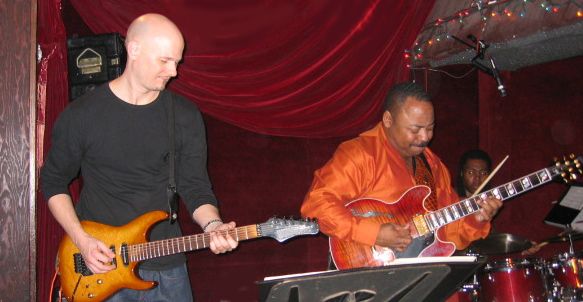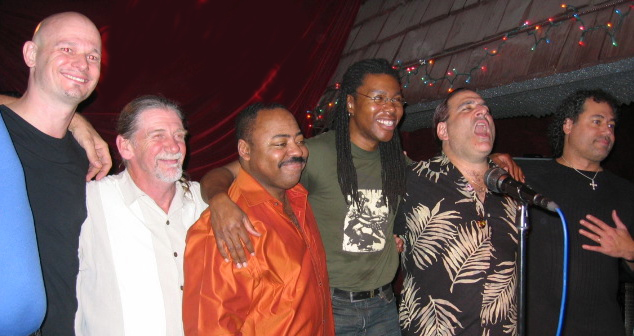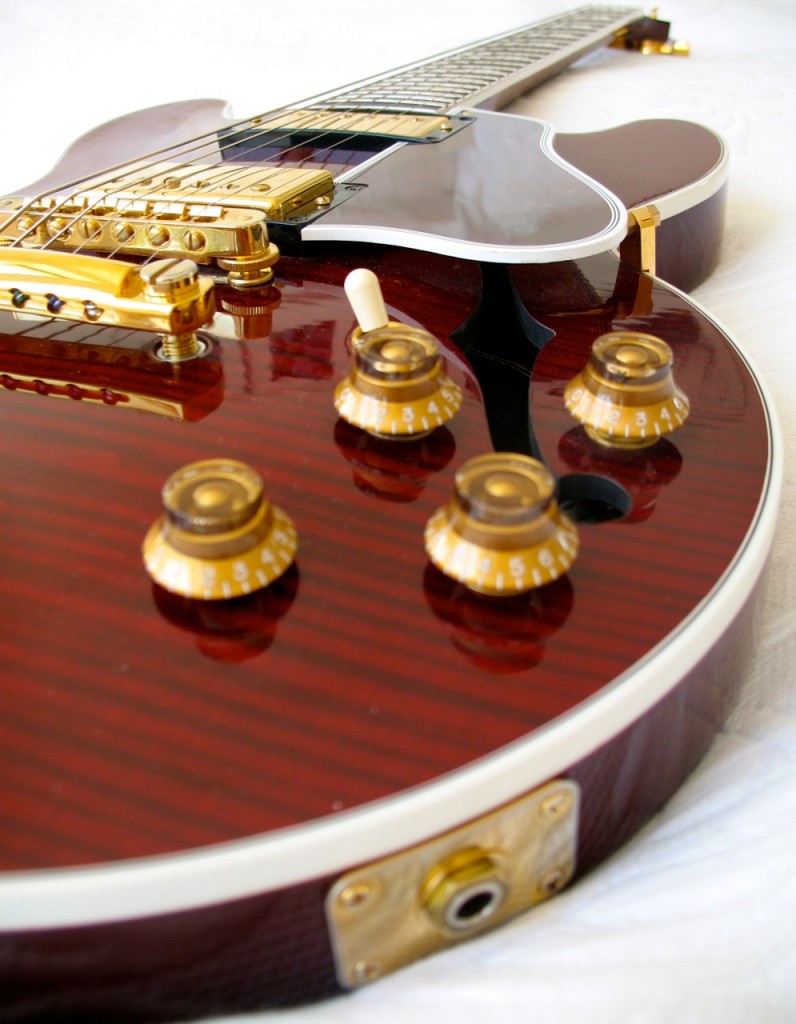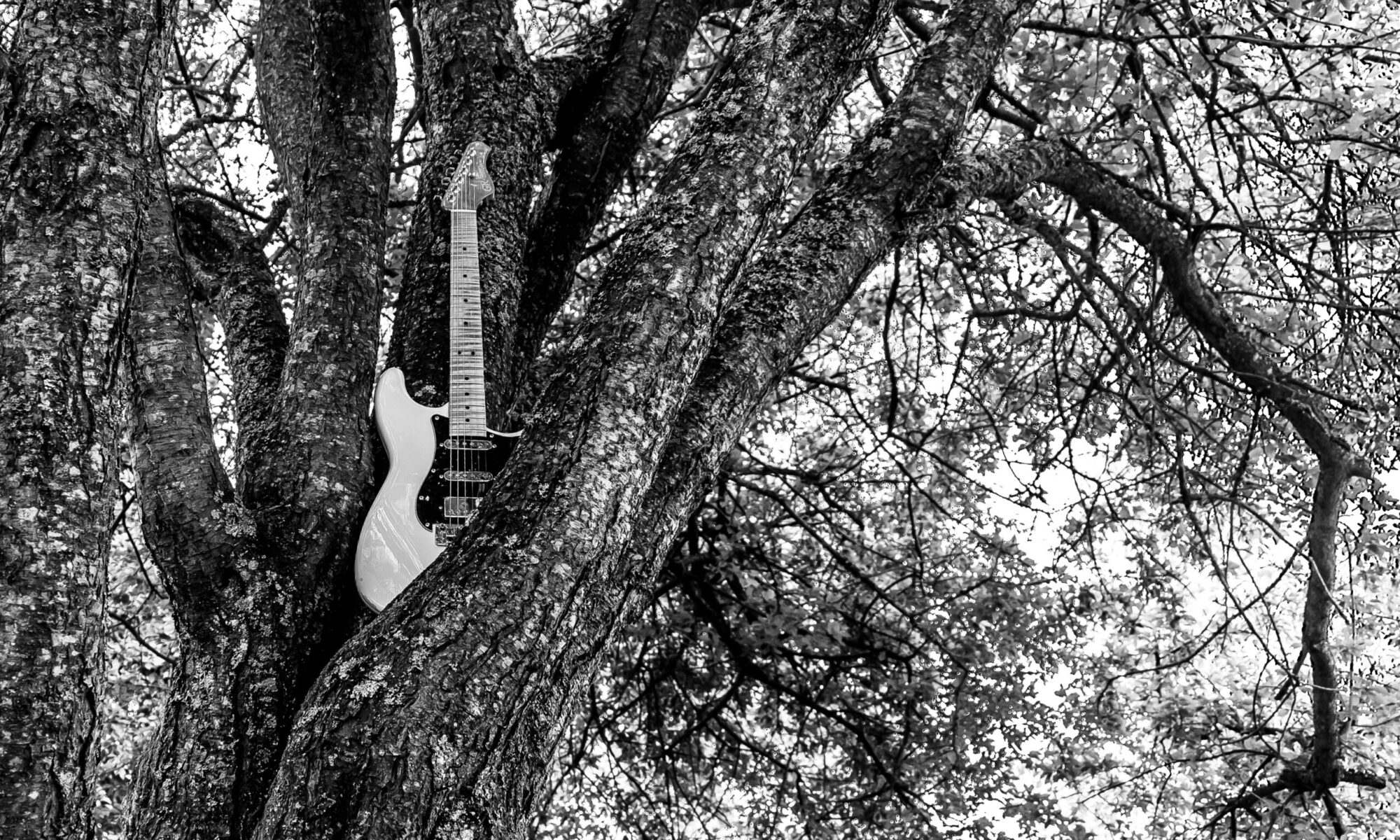A couple of years ago, keyboard player David Garfield introduced me to guitarist Paul Jackson jr. and thereby his Gibson ES-346 that he brought along with him for the gig. At the time the ES-346 was Paul Jackson jr.’s signature model. The guitar sounded fantastic and was super versatile. It had a full and massive tone like a Les Paul, with lots of sustain, and at the same time a warm and jazzy tone when it was needed. I was impressed and maybe a little in love.

After the gig I did some research and found that the model had been discontinued. I browsed the internet from time to time to see if I could find a used one, but without success.

“Roadworn” and “pleked”
Since I couldn’t let the thought of this guitar go, my online search intensified. Suddenly, a red ES-346 came up on Ebay. It was even a little extra special since it was branded “roadworn” on the back of the headstock, right next to the “Gibson Custom Shop” logo. What did this mean? Actually, it has been quite difficult for me to find out what this means. From the information I could gather, I learnt that this roadworn-branding came about, when the guitar was sold at an auction, when Gibson’s Custom Shop closed down. The auction was an “invite only”, and the guitars sold were ones that had been used for people to try them for a specific tour or session, meaning that they were not brand new, but “roadworn”. (If anybody reading this knows more about this, please let me know).
Since I wasn’t sure about this “roadworn” malarky, I emailed Paul and asked if he knew of this specific guitar. Maybe it was made for him, since it was his signature model, and maybe he had discarded it. But no, he didn’t know it and had nothing bad to say about it. I emailed the seller several times, who was very sweet and patient. He emailed me lots of photos and blithely answered my many questions. During this emailing back and forth, it also turned out that the guitar had been “plek’ed”?! More research! It meant that it had new frets, plus a new saddle mounted by a machine. The adjustment after the re-fretting was also done by the machine that had analyzed the neck shape and curve and adjusted the action according to the programmed wishes, concerning action and the owners playing style. Kind of scary when you are used to the good old fashioned way of doing it. But try googling: “plek + guitar” and watch the video clips that come up … pretty impressive.
I transferred the money and suddenly the days were infinitely long. After a couple of weeks, because it had to clear customs, I got the message that I could pick it up at the local post office. The guitar’s hard case was in a fine box wrapped in oceans of cardboard so it took ages for me to unpack. When I finally got to the hard case and opened it, I was very pleased … the guitar was beautiful and wonderful to play – I was totally in love within seconds.

Materials and technically stuff
The materials are the same as on my old custom built Strat-style Washburn, which was my main guitar the last 10-12 years before I got this, but the construction is totally different. It is a hollow body like a ES-335 but it’s slightly smaller than a 335. The fretboard is made of ebony. The first ES-346’s had rosewood, but the Paul Jackson signature model, was made with ebony. The neck is a one piece mahogany that is compound, which means it doesn’t feel thick further up the neck. The body is made of a single piece of mahogany, which is carved out the same way our ancestors made canoes out of tree trunks, but it still has a center block. The mahogany body gives a full and warm tone and the neck made of flamed maple, gives the guitar a very fast response with good attack. The fact that the body isn’t made the same way hollow bodies normally are, allows a rounded back which leaves space for the stomach and “daily specials”. On the back there’s a cover that provides quick and easy access to the electronics.
Speaking of electronics, the pickups are Gibson’s 57 Classic humbuckers, and the “wiring” is classic Gibson, with a volume control and a tone control for each pickup.

Another special thing about this model is the “snake-head”, which doesn’t look like the ordinary Gibson heads. This design makes the strings go straight thru the saddle to the tuners. I’m told that this makes the guitar easier to bend, although I don’t think it’s a major issue … but it looks cool.
Within days I became dependent on this guitar. What a tone and character! I immediately began to use it in the studio and lived happily ever after … or?
Almost – I thought it felt natural with the 0.11’s it was set up with, but I also missed a softer bend, if I wanted to play some bluesy stuff, so I started dreaming about another ES346 for that – but you can’t have it all. I enjoyed the full and warm jazzy tone and started recording guitar parts for my second album “Miss you” with a big smile on my face.
All the very best.
Soren


I am enlightened!!!! Very informative … now I will start looking for a ES346 for my collection! :0)
Thanks Michael – and I totally understand if you want to find one too.
What is the compound radius on the es 346? Thank you
Hi Billy – Actually I don’t know … my guess – guess is that it’s the same as a Les Paul – but I’m not sure – sorry I can’t inform better on that subject.
All the best
Soren
A facebook friend of mine, sent me a link to a forum where “AndyC” gives good information about “roadworn”. I’ve tried to see if I could come in contact with him without luck, since he should have the credit for this information. Therefore I add some of what he wrote here, as a comment – and thank you Andy!!!
In the summer of 2006, Gibson moved its Custom Shop to a larger facility. At the end of their move, in conjunction with their annual Gibson “SummerJam”, they held an auction. They auctioned over 100 guitars that were in the old Custom Shop facility for one reason or another. Some were prototypes, some were loaners, some were returns probably.
Proceeds went to a charity. Lots of cases were on sale because The Custom Shop changed its logo from the “Custom, Art and Historic” logo to “Custom” earlier that year.
The Roadworn stamp got stamped on every guitar they auctioned. I don’t know specifically why, but some said it was in case someone tried to return one via a sales outlet, etc..
Congrats on your 346 twins ; ) I happened across one quite a few years ago through The Gear Page. The posted pic was gorgeous and I kept going back to it day after day. A week later, when it was still available I just couldn’t maintain my willpower and bought it knowing no more than what the owner offered up in our emails. Upon arrival I was astonished. It was so much better than I could have hoped for! Set up was perfect for me with extremely low action and no fret buzz at all. The neck carve was substantial yet superbly comfortable and the sound was the best possible combination of Les Paul and 335. The snakehead headstock is the sexiest hs design Gibson has ever issued. I share your enthusiasm for this model and am surprised there is not more information about them since they were the precurser to the current 336/339 models. Although my primary guitars are all Gustavssons now, I don’t think my 346 will be going anywhere, anytime soon. It hangs with the best! Best regards.
I totally agree with you … it’a an awesome guitar!!
Congrats with yours – Soren
Soren, would you ba able to confirm (or disconfirm) that the ES-346 has a compund radius fretboard?
https://reverb.com/item/497365-gibson-es-346-es-346-custom-shop-historic-flametop-electric-guitar-w-coa-rare
Thanks in advance and best regards,
J. W.
Hey J.
I’m pretty sure that it is compound, if I understood and remember everything correctly. Please be aware of even though it wasn’t on the market that long, there are several different versions of the ES346 – IMHO, is the version that I have (the second version I think), and unfortunately it’s pretty difficult to find for sale, the most interesting version – with ebony fretboard (the first version had rooswood), and bindings around the pickguard and Custom logo on the back of the headstock. The third version har layered pickguard and custom logo on front. The second version is also the same as Paul Jacksons signature model. Good luck Soren
Hi Soren
Thanks for the description of the various incarnations of the 346,
I have one similar to that you describe as yours with the ebony fretboard and custom shop mark on the back of the straight through headstock. The serial number would indicate a 2003 model, and I think it maybe Gingerburst and without a scratch plate
Whilst I bought through a notable source in Gloucestershire some 10/12 years ago, there was no certification and I had become a little concerned that pictures of other 346’s where different from mine. I wondered if it may have been ‘China’ made but your description of yours has allayed my fears, cheers
G
Very interesting Graham.
I think there are quite af few “different” models around.
But most important is how it makes you feel, do you get inspired, and enjoy playing it.
All the very best
Soren
I have an original ‘99 Gibson Custom shop catalogue. When I looked to purchase an ES 346 , they were discontinued. In about 2002 or so , a Gibson rep at the show informed me that the only difference between the 346 and the Paul Jackson model was the truss rod cover. He told me that I could always order any Gibson signature model, so I ordered a PJ model from the “boutique “ shop I patronized. 7 or so months later I opened the case on a “PJ signature model “ with a natural top , no figure, and an almost greenish tint to it. Because, believe it or not , they held no deposit from me , I refused it. Some 8 months later I accepted the 2004 PJ sig model I own today in what appears to be , curiously, cherry sunburst. It came with a “belly cut” custom shop logo on back of the headstock and less of a headstock angle than Les Pauls and 335’s. It , like my Les Paul Florentine may be more semi solid body with a tight one piece carved out body and a 3/8 inch thick solid top. The catalog has no specks for the compound radius of the any of the 3 sister models. It’s tension facilitated a 10 gauge set. It bends well for Rock and the Blues but truly loves Jazz. It’s tone is Arch-Top like brilliant, loud and rich. I would recommend the “PJ” to anyone who could appreciate it.
Soren ,thanks for providing this venue. I have some other info on these models including the ‘99 catalog if you need any information having owned mine for 18 years.
Oh could be great fun to see that catalog 🙂